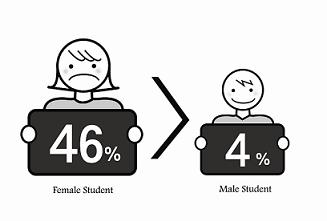
Approximately 46 percent of female students who apply for Korean Income Contingent Loans (ICL) may not be able to repay the principal and interest 35 years after graduation, according to simulation research by Professor Ha Yeon-sub (Yonsei University) in collaboration with the Ministry of Education, Science and Technology (KEST). This is 11.5 times higher than the 4 percent of male debtors who won’t be able to repay the loans.
The ICL program, often called the “study-now-pay-later” program, began in January 2009 when it passed the National Assembly. It allows students to pay back education loans when they start making a consistent income. Compared to conventional loan programs from both banks and the government, students do not have to pay interest while they attend school. Repayment begins after students begin earning more than the poverty threshold for a family of four, 1,592,000 won.
The ICL is available for students under 35 whose annual family income is under 48.39 million won. The Korea Student Aid Foundation (KSAF) began taking loan applications in January and will do so until March 18.
Ha’s simulation shows women who fully repay the loans will take 25 years to do so, compared to 13 years for men. Differences in men’s and women’s earning power explain the variance.
“Women's employment rate and their average wage rate, in comparison to men's, is the lowest among OECD countries,” said Professor Ha.
Women’s employment for 25 to 64 year-olds in Korea is 57 percent, compared to 86 percent for men.
The basic premise behind Ha’s simulation is that students start paying off the debt when they earn 1.5 million won per month, and the repayment rate is 20 percent.
According to the Korea Student Aid Foundation, female students often struggle to get jobs after graduation, so the time they take to fully pay off debts may be longer than male students.
Ha’s research indicates that men’s employment rate starts to decrease at age 50, whereas women’s starts to decline when they reach their 30s.
The simulation also predicted the average default rate will reach 25 percent, 2.5 times higher than the desirable default rate estimated by the government. It also forecast that total loan defaults may reach 2 trillion won by 2040.
Lee Kyung-sook, the chairperson of KSAF, used a Feb. 5 Korea Broadcasting System radio program to suggest solutions to problems with the ICL, especially loan defaults.
Lee said allowing the government to collect student loans from any source of income, like a retirement annuity, could prevent people from sloughing off their debts.
The government may also help women who are unable to work after marriage pay education loan by allowing married couples to consolidate their incomes for repayment. If this system were to be implemented, the KEST expects the default rate for female students to drop from 46 percent to 10.8 percent since husbands will support their wives.
According to an article by Professor Ha in the Aug. 4, 2009 Chosun Ilbo, in order for the ICL to succeed, the government should create systems to track down debtors’ income to reduce the default rate. He also emphasized the importance of improving the educational environment to empower students to find stable jobs.

